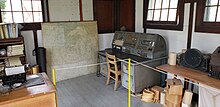
A flight service station (FSS)[1] is an air traffic facility that provides information and services to aircraft pilots before, during, and after flights, but unlike air traffic control (ATC), is not responsible for giving instructions or clearances or providing separation. They do, however, relay clearances from ATC for departure or approaches. The people who communicate with pilots from an FSS are referred to as flight service specialists.
The precise services offered by stations vary by country, but typical FSS services may include providing preflight briefings including weather and notices to airmen (NOTAMs); filing, opening, and closing flight plans; monitoring navigational aids (NAVAIDs); collecting and disseminating pilot reports (PIREPs) and airport surface weather observations; offering traffic advisories to aircraft on the ground or in flight; relaying instructions or clearances from air traffic control; relaying information from or about airborne aircraft to their home bases, military bases or homeland security, providing weather advisories to aircraft inflight, initiating search and rescue on missing VFR aircraft, and providing assistance in an emergency. In many countries, flight service stations also operate at mandatory frequency airports to help co-ordinate traffic in the absence of air traffic controllers, and may take over a control tower frequency at a controlled airport when the tower is closed.[2]
In most cases, it is possible to reach flight service stations either by radio in flight, or by telephone on the ground. Recently, some countries, such as Canada and the United States, have been consolidating flight services into large regional centres, replacing former local flight service stations with remote communications outlets (RCOs)[3] connected to the centres.
- ^ "Aeronautical Information Manual (AIM) - Page 632". faraim.org. Retrieved 2 September 2015.
- ^ FAA order 7110.10[clarification needed]
- ^ "Aeronautical Information Manual (AIM) - Page 682". faraim.org. Retrieved 2 September 2015.
© MMXXIII Rich X Search. We shall prevail. All rights reserved. Rich X Search
